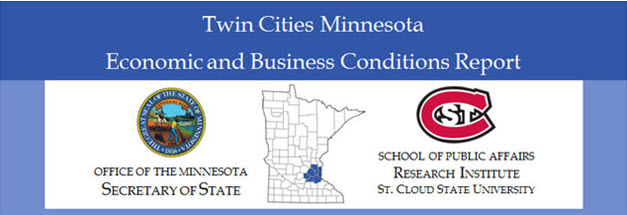Document Type
Research Study
Publication Date
6-2015
Abstract
The Twin Cities economy is expected to grow more slowly over the next several months according to the prediction of the Twin Cities Index of Leading Economic Indicators (LEI). The Twin Cities LEI fell by 5.23 points in this year’s first quarter as three of the five index components declined. The LEI is now 4.1 percent below its level of one year ago. Accounting for the decline in the index are lower residential building permits in the Minneapolis/St. Paul Metropolitan Statistical Area (MSA), higher initial jobless claims at the end of last year, and recent weakness in a general measure of statewide business conditions. A second measure of general business conditions was basically neutral in the first quarter. The one index component with a positive value is a recent increase in new business filings for incorporation and limited liability companies (LLC) in the Twin Cities planning area.
There were 10,494 new business filings with the Office of the Minnesota Secretary of State in the seven-county metro area in the first quarter of 2015—representing a 0.8 percent increase from one year ago. There were 1,553 new regional business incorporations in the first quarter, a 2.6 percent decrease over year ago levels. First quarter new LLC filings in the seven-county metro area were up 4.6 percent—rising to 6,385. New assumed names totaled 2,099 in this year’s first quarter—a reduction of 7.5 percent from the first quarter of 2014. There were 457 new filings for non-profits in the Twin Cities in the first quarter of 2015, 4.8 percent more filings than one year earlier.
Twin Cities employment increased by 1.7 percent over the year ending March 2015. The regional unemployment rate was 3.8 percent in March, an improvement on its 4.6 percent reading one year earlier. April 2015 initial claims for unemployment insurance were below year ago levels, falling by 13.6 percent to 7,021. Job vacancies have increased in the Twin Cities. There are now 101.39 vacancies for every 100 unemployed in the seven-county metro. The labor force expanded in the Minneapolis-St. Paul area by 0.9 percent over the past year. Average weekly hours worked declined in the metro area, although average hourly earnings rose over the past twelve months. The relative cost of living in both Minneapolis and St. Paul appears to have declined.
Recommended Citation
Banaian, King and MacDonald, Richard A., "Twin Cities Area Economic and Business Conditions Report - First Quarter 2015" (2015). Twin Cities Minnesota Economic and Business Conditions Report. 4.
https://repository.stcloudstate.edu/qebcr_tc_mn/4




